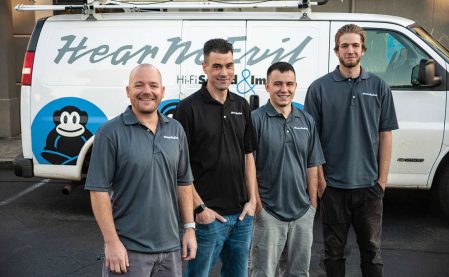Hear No Evil, Salem, Oregon
iPoint Boosts Employee Confidence; Turns Around Jobs Quicker
Precision documentation of projects, scheduling and invoicing brings greater workforce efficiency—and more jobs—to Hear No Evil, Salem, Ore.

Hear No Evil just might be saving on gasoline–thanks to the iPoint business management platform which itemizes all the equipment needed on a jobsite, the installation and service teams have fewer callbacks.
The longer you drag your feet, the longer it takes to get a job complete. That’s not to say that the 11 employees that make up the workforce at Hear No Evil were intentionally sluggish; they just didn’t have all the right tools to stay completely on track.
Coming from a retail background, the Salem, Ore. team had a solid handle on invoicing. Lacking was an efficient means of managing and flow of home installation projects as a growing part of Hear No Evil’s business.
“We had a good accounting and invoicing system,” says company president Chris Rasmussen.
“But for work orders and workflow we were relying on Excel and lots of paperwork—a strategy that was really slowing us down and affecting our profitability.”
Saving Time and Closing Deals
This all turned around when Hear No Evil implemented the iPoint platform about three years ago. Rasmussen says it has singlehandedly streamlined every part of its operations—from procuring equipment and drafting proposals to scheduling projects and managing workflow. He figures that iPoint has accelerated proposal generation by at least 25 percent—and that time saving has trickled into new business.
“When we can build proposals faster and streamline workflow, we have more time to take on other jobs,” Rasmussen explains. “And because our documentation looks so professional, it’s improved our close ratio.”
Minimizing Mistakes
There are a lot of moving parts in a custom design and installation project, and Rasmussen admits that before iPoint mistakes were made and items inadvertently overlooked.
“It wasn’t uncommon for the team to show up at a jobsite missing a piece of equipment,” he admits. “Now, with the right system we are able to accurately document each phase of the job, make changes on the fly, and have the right techs at the right jobs—no running back to the shop for something we may have forgotten.”
Techs carry tablets with them to the jobsite, so they can access the documentation anytime, from anywhere.
These benefits certainly influence Hear No Evil’s bottom line, but it’s the ability of iPoint to factor into proposals ‘modifiers’ like administration fees, labor involved for each piece of equipment, and parts allowances that Rasmussen attributes as the biggest fiscal advantage.
“When we are able to break down jobs to this level of detail it’s surprising how close our quotes on labor are to our actual labor charges. It’s a safety net that helps us be more profitable. And not one customer has complained about or questioned these miscellaneous line-item expenses.”
Instilling Confidence
The accuracy by which Hear No Evil employees are able to break down jobs has instilled a high level of confidence across the entire workforce. When mistakes are fewer, profits are on-point, and workflow is smooth, employees naturally feel more confident doing their jobs.
“We continue to get faster and more comfortable with the iPoint system as time goes on, and it’s now a platform that we completely embrace as a crucial part of our business,” says Rasmussen.
Discovering iPoint—A Last Ditch Effort
Although iPoint is firmly established as Hear No Evil’s sole business management platform, the company endured many years of inefficiency before landing on the solution. Admitting there was a problem was a good first step, toward Hear No Evil’s journey toward iPoint. Rasmussen looked long and hard for a few years to find a system that would streamline Hear No Evil’s operations.
Seemingly with no other options, he was about to sign on the dotted line with a manufacturer of a “very expensive and complicated system,” when he decided to take one more look for something that was more befitting of custom installation business.
“A friendly competitor happened to mention iPoint; after reading about the system online I knew immediately that this was the type of management platform we needed. The system was designed from the ground up by people who have backgrounds in the custom installation business, so there was no trying to fit a square peg into a round hole—the system suited our needs right off the bat and continues to do so today.”

